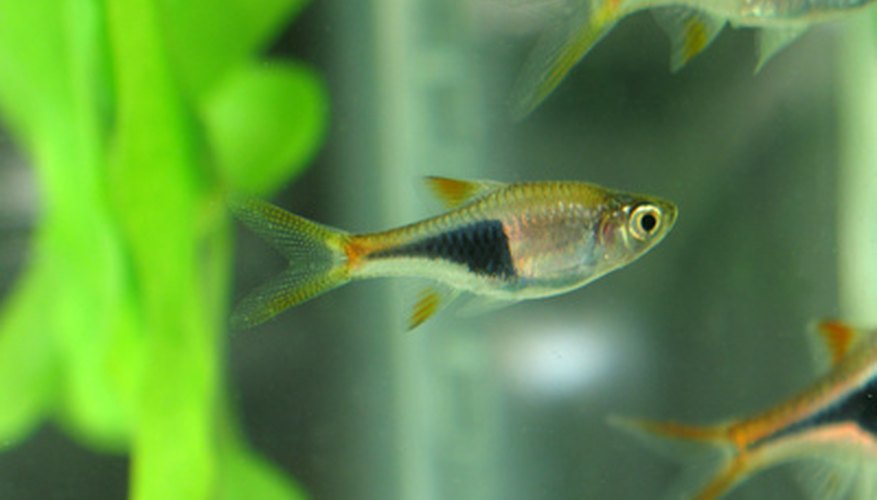A small, metallic-looking fish, harlequin rasboras are popular aquarium fish because of their friendly, schooling nature and hardiness. They are freshwater fish found in the rivers and streams of Southeast Asia. Harlequin rasboras are easily distinguished from most other species of fish thanks to its distinctive black triangle. As with other aquarium fish, positive identification of males and females is not easy.
About Harlequin Rasboras
Harlequin rasboras (Trigonostigma heteromorpha) are native to small rivers and streams of Thailand, eastern Sumatra and the Malay Peninsula. A small, friendly and easy-to-keep fish, harlequin rasboras are popular for aquariums because they interact well with each other and other species. Harlequin rasboras prefer to shoal and should be kept with 10 or more others.
Keeping Harlequin Rasboras
Harlequin rasboras are generally easy keepers, but they should only be introduced to an established tank. Because they prefer larger groups, they will require a larger tank, generally at least 20 gallons. Harlequin rasboras are omnivores and will eat flake food.
Identifying the Sex of Harlequin Rasboras
Distinguishing a male harlequin rasbora from a female is difficult. Males are generally smaller. The dorsal patch--sometimes referred to as "the pork chop"--on males has a straight edge toward the head, is slightly rounder at the bottom and has an extended tip when compared to the dorsal patch of females.
Breeding Harlequin Rasboras
Harlequin rasboras breeding is difficult, although it has been done in captivity. These fish require precise water conditions when trying to reproduce. According to Aquatic Community, the fish require the water hardness to be no higher than 1.5 to 2.5 (4) DH. The pH-value can be kept around 6.0 and the temperature should be at 28 degrees Celsius. Harlequin rasboras lay their eggs under leaves.
- Harlequin rasboras breeding is difficult, although it has been done in captivity.
- These fish require precise water conditions when trying to reproduce.
Successful Breeding
For the best results, pair a female harlequin rasbora of about 9 to 12 months with a male of about two years in a shallow pool containing the appropriate water conditions and plenty of broad leaves. After spawning, the parents should be returned to the larger tank, and the eggs left in a dark, quiet place. The water should be 4 to 6 inches above the highest eggs. The eggs will hatch in 18 to 36 hours, although the hatchlings will take about three to five days to begin swimming. Feed the fry infusorians for the first week or so, and then switch to brine shrimp. Young harlequin rasboras resemble adults after about eight to 10 weeks.
- For the best results, pair a female harlequin rasbora of about 9 to 12 months with a male of about two years in a shallow pool containing the appropriate water conditions and plenty of broad leaves.
- After spawning, the parents should be returned to the larger tank, and the eggs left in a dark, quiet place.
